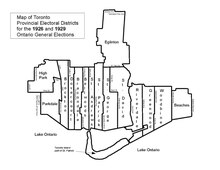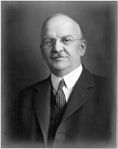1926 Ontario general election
| |||||||||||||||||||||||||||||||||||||||||||||||||||||||||||||||||
112 seats in the 17th Legislative Assembly of Ontario 57 seats were needed for a majority | |||||||||||||||||||||||||||||||||||||||||||||||||||||||||||||||||
|---|---|---|---|---|---|---|---|---|---|---|---|---|---|---|---|---|---|---|---|---|---|---|---|---|---|---|---|---|---|---|---|---|---|---|---|---|---|---|---|---|---|---|---|---|---|---|---|---|---|---|---|---|---|---|---|---|---|---|---|---|---|---|---|---|---|
| |||||||||||||||||||||||||||||||||||||||||||||||||||||||||||||||||
| |||||||||||||||||||||||||||||||||||||||||||||||||||||||||||||||||
The 1926 Ontario general election was the 17th general election held in the Province of Ontario, Canada. It was held on December 1, 1926, to elect the 112 Members of the 17th Legislative Assembly of Ontario ("MLAs").[1]
Background[]
The United Farmers of Ontario decided to withdraw from electoral politics after having been defeated in the 1923 election, and most of its MPPs redesignated themselves as Progressives with former UFO Attorney-General William Edgar Raney becoming party leader. Nevertheless, several MPPs, including Raney himself, continued to run as candidates endorsed by local UFO associations.
Leslie Oke and Beniah Bowman were opposed to Raney's leadership as he was not a farmer. They were also opposed to the creation of a new Progressive Party which would not focus exclusively on farmers' issues, so they chose to remain as UFO MPPs. Bowman later resigned from the legislature before the election.
The fracture of the UFO, together with a large number of resignations from MPPs who chose to run federally in the elections of 1925 and 1926, significantly changed the composition of the Assembly:
| Seat | Before | Change | |||||
|---|---|---|---|---|---|---|---|
| Date | Member | Party | Reason | Date | Member | Party | |
| Lennox | August 23, 1923 | John Perry Vrooman | █ Liberal | Died in office | October 22, 1923 | Charles Wesley Hambly | █ Conservative |
| Toronto Northwest - A | May 15, 1924 | Thomas Crawford | █ Conservative | Accepted provincial appointment | July 7, 1924 | William Henry Edwards | █ Conservative |
| Simcoe South | April 14, 1925 | William Earl Rowe | █ Conservative | Resigned to run in 1925 federal election | █ Vacant | ||
| Kenora | April 14, 1925 | Peter Heenan | █ Labour | Resigned to run in 1925 federal election | █ Vacant | ||
| Cochrane | April 14, 1925 | Malcolm Lang | █ Liberal | Resigned to run in 1925 federal election | █ Vacant | ||
| Norfolk North | April 14, 1925 | █ Progressive | Resigned to run in 1925 federal election | █ Vacant | |||
| Grey Centre | April 14, 1925 | Dougall Carmichael | █ Progressive | Resigned to run in 1925 federal election | █ Vacant | ||
| Kent East | April 14, 1925 | Manning William Doherty | █ Progressive | Resigned seat to promote cooperative movement | █ Vacant | ||
| London | August 15, 1925 | Adam Beck | █ Conservative | Died in office | █ Vacant | ||
| Middlesex East | April 8, 1926 | John Willard Freeborn | █ Progressive | Resigned to run in 1926 federal election | █ Vacant | ||
| Manitoulin | April 8, 1926 | Beniah Bowman | █ United Farmers | Resigned to run in 1926 federal election | █ Vacant | ||
| Kent West | October 11, 1926 | █ Liberal | Died in office | █ Vacant | |||
Redistribution of seats[]


A 1925 Act provided for the redistribution of the Legislative Assembly into 112 ridings for the election.[2]
The dual-member ridings in the City of Toronto, in effect since the 1914 election, were abolished and replaced by single-member seats:
| Abolished ridings | New ridings |
|---|---|
| |
| Split between St. David, St. George and Riverdale | |
| |
Beaches was drawn out from York East, and High Park from York West.
There were other changes made to ridings elsewhere in the Province:
- Brant and Brant South were reorganized into Brant County and Brantford
- Bruce West was divided between Bruce North and Bruce South
- Durham East and Durham West were combined to form Durham
- Frontenac and Lennox became Frontenac—Lennox
- Grey Centre wasa divided between Grey North and Grey South
- Hamilton Centre was created from parts of Hamilton East and Hamilton West
- Huron Centre was split between and Huron South
- London was split into London North and London South
- Middlesex East was split between Middlesex North and Middlesex West
- Norfolk North and Norfolk South merged to form
- Northumberland East and Northumberland West became Northumberland
- Ottawa West was divided to form and Ottawa South
- Peterborough East and Peterborough West were reorganized to form and
- Wellington East and Wellington West merged to form Wellington Northeast
- was divided to form and Windsor West
- York South was carved out from York West
A further Act in 1926 merged Simcoe South and Simcoe West into Simcoe Southwest, and divided Cochrane into Cochrane North and Cochrane South.[3]
Summary[]
The Ontario Conservative Party, led by Howard Ferguson, was re-elected for a second term in government. The principal issue of the campaign was the government's proposal to repeal the Ontario Temperance Act, replacing prohibition with government control of liquor sales. The Liberal and Progressive parties both campaigned against repeal, and one of Ferguson's ministers, William Folger Nickle, resigned from the cabinet and ran for re-election against the government as a Prohibitionist candidate.
The Ontario Liberal Party, led by W.E.N. Sinclair, maintained its 14 seats, while the Progressives won 10. Four Liberal-Progressive candidates were also elected, along with several independents. Oke was the only UFO MPP who was re-elected as such, and he was joined by Thomas Farquhar from Manitoulin and Farquhar Oliver from Grey South. The latter won with the assistance of federal MP Agnes MacPhail. Karl Homuth of Waterloo South was the only Labour MPP returned.
Results[]
| Political party | Party leader | MPPs | Votes | |||||||
|---|---|---|---|---|---|---|---|---|---|---|
| Candidates | 1923 | Dissol. | 1926 | ± | # | % | ± (pp) | |||
| Conservative | Howard Ferguson | 112 | 75 | 74 | 72 | 3 |
634,635 | 55.36% | 5.80 | |
| Liberal | W.E.N. Sinclair | 49 | 14 | 11 | 14 | 197,623 | 17.24% | 4.12 | ||
| Progressive | William Raney | 17 | – | 11 | 10 | 10 |
72,445 | 6.32% | Split from UFO | |
| Liberal–Progressive | 9 | – | – | 4 | 4 |
45,733 | 3.99% | New | ||
| United Farmers | Leslie Oke | 3 | 17 | 1 | 3 | 14 |
15,417 | 1.34% | 19.77 | |
| Labour | 3 | 4 | 3 | 1 | 3 |
14,794 | 1.29% | 3.47 | ||
| Independent Liberal | 7 | – | 1 | 4 | 4 |
21,002 | 1.83% | New | ||
| Independent Conservative | 6 | – | – | 2 | 2 |
19,198 | 1.67% | New | ||
| Independent Progressive | 1 | – | – | 1 | 1 |
5,861 | 0.51% | New | ||
| Liberal-Prohibitionist | 2 | – | – | 1 | 1 |
9,115 | 0.80% | New | ||
| Independent | 1 | 1 | – | – | 1 |
2,912 | 0.25% | 1.37 | ||
| Prohibitionist | 27 | – | – | – | 96,868 | 8.45% | New | |||
| Liberal-Labour | 2 | – | – | – | 4,633 | 0.40% | New | |||
| Progressive-Liberal | 1 | – | – | – | 3,941 | 0.34% | New | |||
| Liberal-Labour-Prohibitionist | 1 | – | – | – | 2,298 | 0.20% | New | |||
| Vacant | 10 | |||||||||
| Total | 241 | 111 | 111 | 112 | 1,146,475 | 100.00% | ||||
| Blank and invalid ballots | 6,717 | |||||||||
| Registered voters / turnout | 1,805,061 | 63.89% | 6.15 | |||||||
| Party | Seats | Votes | Change (pp) | ||
|---|---|---|---|---|---|
| █ Conservative | 72 / 112 |
55.36% |
5.80 | ||
| █ Liberal | 14 / 112 |
17.24% |
-4.12 | ||
| █ Progressive | 10 / 112 |
6.32% |
6.32 | ||
| █ Liberal–Progressive | 4 / 112 |
3.99% |
3.9 | ||
| █ United Farmers | 3 / 112 |
1.34% |
-19.77 | ||
| █ Labour | 1 / 112 |
1.29% |
-3.47 | ||
| █ Other | 8 / 112 |
6.01% |
4.39 | ||
| █ Prohibitionist | 0 / 112 |
8.45% |
8.45 | ||
Notes[]
References[]
- ^ "1926 General Election". Elections Ontario. Elections Ontario. Retrieved January 3, 2021.
- ^ The Representation Act, 1925, S.O. 1925, c. 7
- ^ The Representation Act, 1926, S.O. 1926, c. 2
See also[]
- Politics of Ontario
- List of Ontario political parties
- Premier of Ontario
- Leader of the Opposition (Ontario)
Further reading[]
- Hopkins, J. Castell, ed. (1927). The Canadian Annual Review of Public Affairs, 1926–27. Toronto: The Annual Review Company.
- 1926 elections in Canada
- General elections in Ontario
- 1926 in Ontario
- December 1926 events

